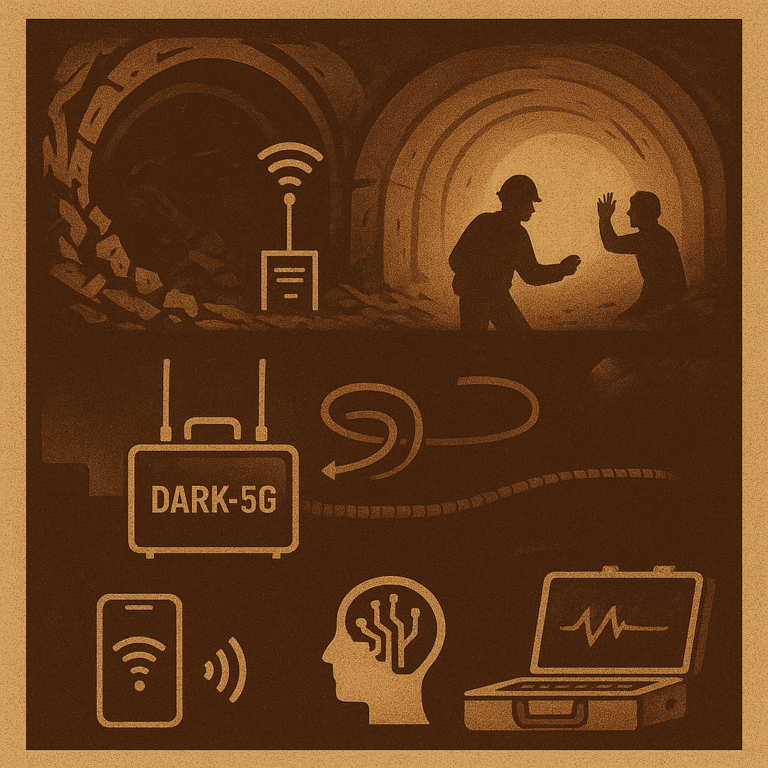DARK-5G: The 5G Speed Test - What We Learned from a DIY Network

Have you ever wondered what’s really going on behind the scenes when you get a blazing-fast 5G connection—or why your signal sometimes slows to a crawl? We were curious too. So, we decided to move beyond just using 5G and build our own small-scale network to test two of the most critical factors in wireless performance: bandwidth and distance.
Using a low-cost, powerful device, we set up our own 5G Standalone (SA) network to find out: how much does more bandwidth really help, and how quickly do speeds drop when you step away from the transmitter? The results were fascinating.
The Tech: Our Mini 5G Lab
To run our experiment, we needed our own private 5G network. The core of our setup was a USRP B205mini, a compact and affordable device known as a software-defined radio (SDR). Think of it as a programmable radio that can be taught to act like a cell tower.
We configured it to broadcast in the n78 frequency band, a popular and widely used band for 5G worldwide. Our goal was to measure two key metrics:
Downlink (DL): The speed of data coming to our device. This is what you use for streaming videos, downloading files, and browsing websites.
Uplink (UL): The speed of data going from our device. This is used for uploading photos, sending emails, and video calls.
We tested these speeds across a range of bandwidths, from 10 MHz to 60 MHz. Think of bandwidth as the number of lanes on a highway. A 10 MHz bandwidth is like a single-lane road, while 60 MHz is a multi-lane superhighway, allowing much more data to flow at once.
The Experiment: Putting Speed to the Test
We measured the downlink and uplink performance under two simple conditions:
Close Range: At a distance of 1 meter, representing an ideal connection.
Across the Room: At a distance of 7 meters, simulating a more realistic indoor scenario.
Here are the complete results we collected:

The Results: What the Data Revealed
After running our tests, three clear patterns emerged.
1. More Bandwidth is a Game-Changer for Downloads At close range, increasing bandwidth had a massive impact on download speeds. As you can see in the table, moving from 10 MHz to 60 MHz at a 1-meter distance boosted our download speed from just 23.1 Megabits per second (Mbit/s) to an impressive 173 Mbit/s. That’s over a 7x performance increase, confirming that a wider “data highway” allows for significantly faster downloads when the signal is strong.
2. Distance Can Cut Download Speeds in Half Stepping back to 7 meters told a different story. At nearly every bandwidth setting, the download speed dropped by about 50% or more. For example, at the maximum 60 MHz bandwidth, our speed fell from 173 Mbit/s down to 83.3 Mbit/s. This demonstrates a fundamental rule of wireless signals: they get weaker over distance, and this “signal attenuation” has a major impact on performance.
3. Uplink Speeds Are More Consistent Interestingly, our upload speeds behaved very differently. While they improved with more bandwidth, the gains were far more modest, maxing out at 32 Mbit/s. Furthermore, upload speeds were much less affected by the increase in distance. This suggests that for this particular setup, other factors besides bandwidth and distance might be limiting the uplink performance.
Conclusion: Why This Matters
Our experiment shows the clear trade-offs between bandwidth and distance in a 5G network. While high-frequency 5G can deliver incredible download speeds, it is most effective at short ranges. This is why a single 5G tower can’t cover a massive area with top speeds; the network relies on a dense grid of transmitters.
These findings are essential for engineers designing the wireless systems of the future. By understanding how to balance these factors, they can optimize networks for specific environments—whether it’s ensuring flawless video streaming in a crowded stadium or providing a stable connection for smart devices in a home. Our low-cost setup proves that valuable research can be done to help build the faster, more reliable networks of tomorrow.



